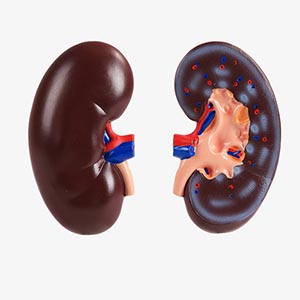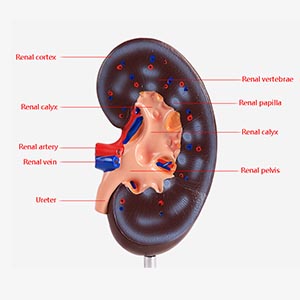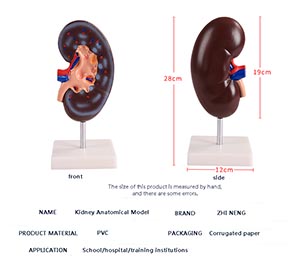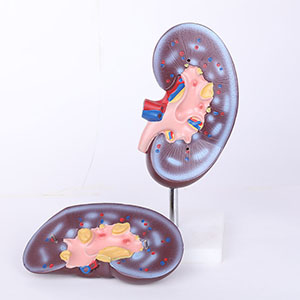In medical education, kidney anatomy model, as a teaching tool, has been widely used in various teaching links. Especially for medical students, kidney model is not only a bridge to learn basic anatomy, but also the key to master clinical skills and improve academic ability. Through the application of the model, students can more effectively understand the structure and function of the kidney, improve the proficiency of clinical operations, and be fully prepared for future medical practice.
1. Technical help

The kidney model can provide medical students with an intuitive, clear display of the anatomy, which is crucial in the actual learning process. The structure of kidney is complex, including tubules, corpuscles, medulla, cortices, blood vessels and so on. Through a life-size, carefully depicted three-dimensional model of the kidney, students can clearly see the spatial relationships of the various parts, the blood flow path and its location in the human body. This intuitive way of learning is more vivid and easy to understand than traditional two-dimensional images or book illustrations.
For the study of basic medicine, the kidney model not only helps students understand the anatomical structure, but also provides insight into how the kidney interacts with other organ systems. For example, students can simulate how the kidneys regulate water, electrolytes, and acid-base balance through the renal tubules. The multi-angle and multi-level display of the model enables students to understand the physiological functions of the kidney more comprehensively.
2. Academic and professional improvement

One of the core objectives of medical education is to train students to have a solid academic foundation, and the renal anatomy model is undoubtedly a tool that cannot be ignored in this process. Through the kidney model, students are able to gain an in-depth understanding of the relationship between pathological changes in the kidney and physiological mechanisms. For example, when studying kidney diseases such as nephritis, kidney failure, kidney stones, etc., models can help students better understand how these pathological processes affect kidney structure and function. In addition, the kidney model also provides students with a practical platform to analyze the mechanism of disease, helping students learn pathological changes in a visual way, and stimulating them to think more deeply about academic issues.
Medical students need not only a basic knowledge of anatomy, but also the ability to diagnose diseases. The kidney model helps students grasp the diagnosis of kidney related diseases by showing the changes of kidney structure in normal and pathological state. For example, students can learn how to identify different types of pathological changes by comparing a normal kidney model with a kidney stone, kidney cyst or kidney tumor model, thereby developing their clinical observation and judgment skills.
3. Training of clinical skills

The study of clinical skills is the key link in medical education. Renal models play an important role in this process. Through the use of models, students are able to carry out simulation operations and experiments on the basis of theoretical learning and master basic clinical skills. For example, kidney models can be used to simulate procedures such as kidney puncture, kidney biopsy, etc., which students can practice over and over without risk to ensure that they can perform the procedure efficiently and safely in an actual clinical setting.
In addition, the kidney model also has great application value in the training of clinical skills, especially in the difficult operations such as kidney dialysis and kidney transplantation. Through the model, students are able to intuitively understand the specific role of the kidney in these treatments, simulate various operational techniques during dialysis, and thus prepare for future clinical work.
Kidney model can not only help students master the technical operation, but also improve their comprehensive clinical judgment ability. In the process of diagnosing and treating kidney diseases, doctors need to comprehensively consider patients' medical history, clinical manifestations, examination results and other information, and the model can help students more intuitively understand how these information play a role in actual cases, and cultivate their systematic thinking and clinical reasoning ability.
4. Clinical significance and future prospects

The implications of the kidney model in medical education go far beyond classroom learning. With the continuous development of medical technology, the diagnosis and treatment of kidney diseases are becoming increasingly complex, and clinicians need to have more solid professional knowledge and skilled technical operation in the face of different diseases. By providing realistic anatomical structure and physiological simulation, kidney models enable medical students to better grasp complex disease diagnosis, treatment methods, and even play an important role in cutting-edge fields such as personalized therapy and precision medicine.
Conclusion
All in all, kidney models play a crucial role in the development of clinical skills of medical students. From technical training to the consolidation of academic knowledge, to the improvement of clinical operation skills, the kidney model provides students with a wealth of learning resources. Through this efficient and intuitive teaching method, students can not only have a deeper understanding of the anatomy and physiological function of the kidney, but also cultivate their clinical thinking and practical ability, and finally lay a solid foundation for future clinical work.
